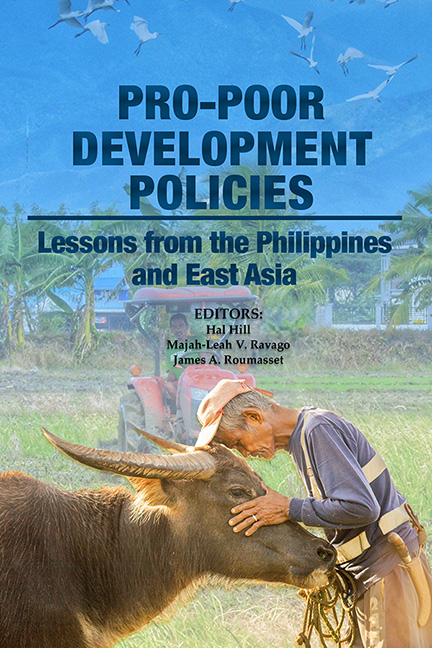Book contents
- Frontmatter
- Dedication
- Contents
- Figures, Tables and Boxes
- Foreword
- Foreword
- Message
- Preface and Acknowledgements
- About the Editors
- About the Contributors
- Acronyms
- Part 1 Introduction and Synthesis
- Part 2 Agricultural and Economic Development
- Part 3 Economic Policies for Achieving Targeted Levels of Living in the Philippines
- Part 4 Inequality and Economic Development
- Part 5 Competition Law and Policy
- Part 6 International Dimensions
- Index
11 - The Limits of Trade Policy Liberalization in the Philippines
Published online by Cambridge University Press: 09 January 2024
- Frontmatter
- Dedication
- Contents
- Figures, Tables and Boxes
- Foreword
- Foreword
- Message
- Preface and Acknowledgements
- About the Editors
- About the Contributors
- Acronyms
- Part 1 Introduction and Synthesis
- Part 2 Agricultural and Economic Development
- Part 3 Economic Policies for Achieving Targeted Levels of Living in the Philippines
- Part 4 Inequality and Economic Development
- Part 5 Competition Law and Policy
- Part 6 International Dimensions
- Index
Summary
INTRODUCTION
The Philippines struggled in the 1980s and 1990s to lower poverty levels amid an inward-oriented economic policy. Poverty levels hovered around 30–40 per cent until the year 2000. The situation can be traced largely to slow economic growth, which averaged only 1.3 per cent annually, and high unemployment, which averaged 9.3 per cent during those decades. In terms of economic structure, the average share of agriculture had fallen from more than 20 per cent in the 1980s to 16 per cent in 2000. Meanwhile, the share of services increased from about 40 per cent to 52 per cent, while that of industry remained largely unchanged. This effectively transitioned the country into a services-led economy without going through an industrialization phase typical in the evolution of similar economies.
As regards international trade, the country’s total trade was equivalent to one-third of the gross domestic product (GDP) in the 1980s, increasing to nearly 100 per cent of GDP in 1998 prior to the Asian financial crisis. Expanding trade was the natural outcome as the country embarked on a trade and financial liberalization policy, coupled with privatization, during this period. This strategy was aimed at increasing investment and export capacities. It included unilateral tariff reduction from the 1980s from up to 100 per cent to a range of 10–50 per cent. The country also participated actively in trade agreements, particularly the ASEAN Free Trade Area-Common Effective Preferential Tariff (AFTA‑CEPT) in 1993, the General Agreement on Tariffs and Trade‑World Trade Organization (GATT-WTO) in 1995, and the ASEAN Trade in Goods Agreement (ATIGA) in 2009. In addition, the country was party to free trade agreements entered into by the ASEAN bilaterally with China, Japan, Korea, and Australia and New Zealand during the 2000s.
Beyond the opening of trade and relaxing of tariffs, the economy also implemented liberalization of industries to attract foreign investments. Annual foreign investment inflows had remained below US$1 billion from the 1980s to the 1990s. Liberalization and privatization reforms in the mid-1990s helped raise investments above US$2 billion, as investments were attracted in telecommunications, water utilities and banks, among others.
- Type
- Chapter
- Information
- Pro-poor Development PoliciesLessons from the Philippines and East Asia, pp. 280 - 310Publisher: ISEAS–Yusof Ishak InstitutePrint publication year: 2022



